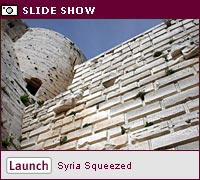Syria Squeezed
My boyfriend and I rent a car, drive out of Damascus, and a few hours later arrive at a castle. It is a vast, intact, medieval hilltop fortress, but not enough people visit to warrant a formal parking lot, so we pull up near the front steps. An elderly crippled man insists he will watch our car, guarding it, perhaps, from the half-dozen underworked postcard vendors. (When we go to retrieve it, we find that a fruit-seller has boxed us in with his wooden cart, but we tip the old man anyway.) The steps lead us into a dark, cavernous, upward-sloping tunnel. After a zig and a zag, we come into a vaulted room and then into a bright courtyard with rooms leading off it in all directions. Steps lead up from the courtyard to stone decks, beyond which we can see crenellated walls and watchtowers.
Krak des Chevaliers is a legacy of the Crusaders, who built upon a smaller fortress already here. With expansive views of the fields below, it looks over the breach between two mountain ranges. Once upon a time, control over this route from the interior to the sea meant control over Syria.
A man sidles up to us and listlessly points out a room. "Stables for horses," he says, and follows us a little. I stop and tell him directly that we do not want a guide and would like to be left alone. My boyfriend, who is more sensitive about such things, feels some guilt. I think, though, that like me he is relieved; we can now wander lazily without the minor obligation of payment or the more onerous one of making polite conversation. Without, in short, any sense of obligation.
Bound for Jerusalem, the zealots of the First Crusade used some spectacularly grotesque tactics as they marched southward in 1098. After winning a victory at Aleppo in February of that year, a Crusader army took the severed heads of its victims and marched to Antioch, where it catapulted them over the city walls and onto the residents. In December, the Christian army fell upon the people of Ma'arra. Then it ate them.
"In Ma'arra our troops boiled pagan adults in cooking-pots; they impaled children on spits and devoured them grilled," wrote the Frankish chronicler Radulph of Caen, cited in Amin Maalouf's The Crusades Through Arab Eyes. (The Christian commanders acknowledged the cannibalism in a letter to the pope, who had ordered the Crusade, saying famine made them do it.)
In morbid fear, the peasants of the surrounding plain took refuge in the fortress where we are standing, but the Christians seized the site in early 1099. Later that year, they breached the walls of Jerusalem, slaughtered about 70,000 people, and expelled the surviving Muslims and Jews.
We sit in the sun and take a few photos. There is a tour group being guided around in English, but they quickly recede from sight and earshot. We wander in and out of rooms and look out through the narrow slits in the stone that were once used to fire arrows. We can see the whole green valley floor below, rolling away into the hazy distance. On one of the wide stone verandas, a man offers to sell us batteries for the camera.
In 1144, the Christian count of Tripoli gave this castle to the Knights Hospitaller, a militant monastic order. They expanded it into the largest Crusader fortress in the Holy Land, capable of holding more than 2,000 men and provisions to survive a five-year siege. Muslim armies besieged it a number of times, but the knights held onto it until 1271.
After leaving the castle, we take a winding road to the coast, stopping for coffee in Safita. An 88-foot stone tower, the remains of another Crusader-era fortress, looms over the mountain town. Nearing Lattakia, we pass orange groves and field upon field of tomatoes housed under translucent plastic tents. We drive through the busy town center, and just north of town we check into a nearly empty five-star hotel on the beach.
Though the Crusaders were on the ragtag side themselves, their zeal and barbarity enabled them to plow through Muslim states that were weak and constantly at war with one another. Maalouf, who is a Lebanese journalist and novelist, makes an interesting observation in the epilogue to his Crusades book. After 300 years, the Crusaders were ultimately defeated and their principalities destroyed; the Arab world seemed to have won a stunning victory. But then a strange thing happened: The culture of the barbaric Europeans went on to retrench and prosper. Arab culture, which had been at a scientific and artistic peak, slid into decline.
Western civilization prospered, moreover, in part thanks to ideas it picked up in the East. The invaders learned Arabic, and through it inherited the learning of Greek civilization, which had not been preserved in Europe. "In medicine, astronomy, chemistry, geography, mathematics, and architecture, the Franj drew their knowledge from Arabic books, which they assimilated, imitated, and then surpassed," Maalouf writes. Centuries later, a handful of Asian states would do the same thing vis-à-vis Western civilization, becoming economic powers that would invent and produce cameras like mine.
The Arabs quite naturally did not learn the invaders' languages. "Throughout the Crusades, the Arabs refused to open their own society to ideas from the West," Maalouf writes. "And this, in all likelihood, was the most disastrous effect of the aggression of which they were the victims."
We return to Damascus and later Paris with our embarrassment of riches. In a couple of weeks I will go see one of those trivial byproducts of Western civilization that makes my life pleasant: A company in Hollywood has spent $130 million to tell a story about the Crusades.
